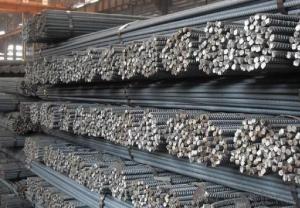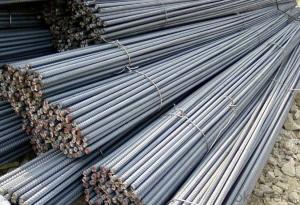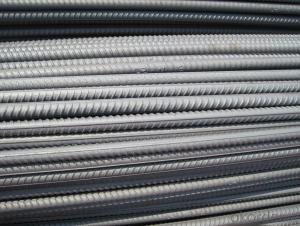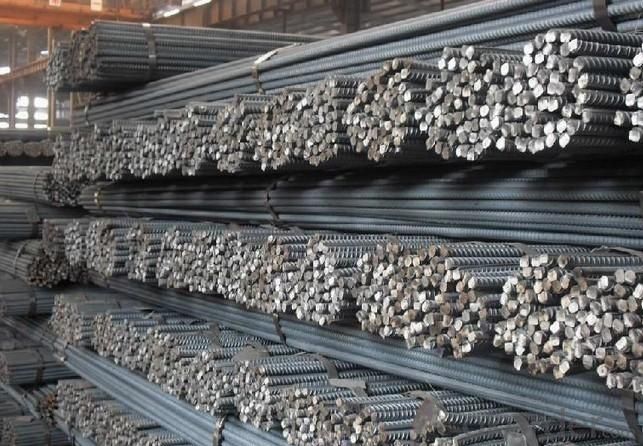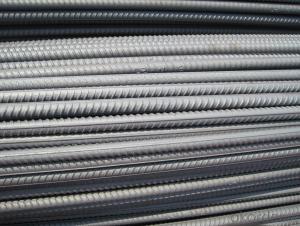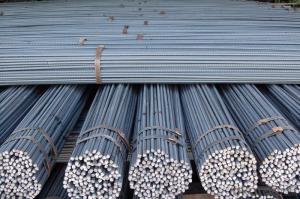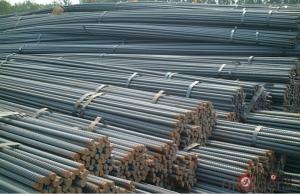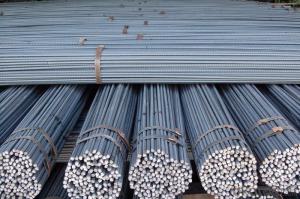GB Standard HRB400 Steel Deformed Bar 22mm/25mm
- Loading Port:
- Tianjin
- Payment Terms:
- TT or LC
- Min Order Qty:
- 50 m.t
- Supply Capability:
- 20000 m.t/month
OKorder Service Pledge
OKorder Financial Service
You Might Also Like
GB Standard HRB400 Steel Deformed Bar 22mm/25mm
Description:
-Standard: GB
-Material: HRB400
-Specification:
| Diameter(mm) | Section Area(mm2) | Mass(Kg/m) | Length(m) |
| 22 | 380.1 | 2.98 | 9, 12 or as customs' request |
| 25 | 490.9 | 3.85 | 9, 12 or as customs' request |
Chemical Composition(%) of GB Standard HRB400 Steel Deformed Bar 22mm/25mm:
| C | Mn | Si | S | P | V |
| ≤0.25 | ≤1.60 | ≤0.08 | ≤0.045 | ≤0.045 | 0.04-0.12 |
Mechanical Properties of GB Standard HRB400 Steel Deformed Bar 22mm/25mm:
Yield Strength (N/cm²) | Tensile Strength (N/cm²) | Elongation (%) |
≥400 | ≥570 | ≥14 |
Usage and Applications of GB Standard HRB400 Steel Deformed Bar 22mm/25mm:
Deformed bar is widely used in buildings, bridges, roads and other engineering construction. Big to highways, railways, bridges, culverts, tunnels, public facilities such as flood control, dam, small to housing construction, beam, column, wall and the foundation of the plate, deformed bar is an integral structure material. With the development of world economy and the vigorous development of infrastructure construction, real estate, the demand for deformed bar will be larger and larger.
Packaging & Delivery of GB Standard HRB400 Steel Deformed Bar 22mm/25mm:
Packaging Detail: products are packed in bundle and then shipped by container or bulk vessel, deformed bar is usually naked strapping delivery, when storing, please pay attention to moisture proof. The performance of rust will produce adverse effect.
Each bundle weight: 2-3MT, or as required
Payment term: TT or L/C
Delivery Detail: within 45 days after received advanced payment or LC.
Label: to be specified by customer, generally, each bundle has 1-2 labels
Trade terms: FOB, CFR, CIF
Images of GB Standard HRB400 Steel Deformed Bar 22mm/25mm:

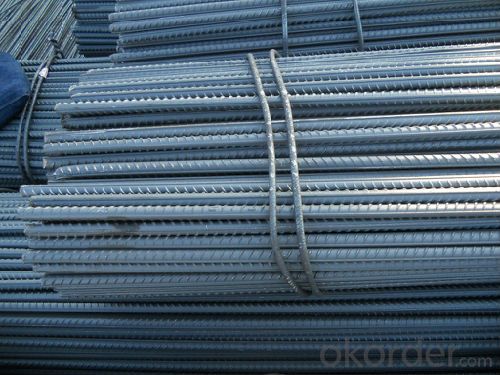
*If you would like to get our price, please inform us the size, standard/material and quantity. Thank you very much for your attention.
- Q: What is the specific concept of thread steel through water and what is the difference?
- Most of the thread steel is subjected to self - tempering after water cooling, and the tempered bainite is obtained. The advantage is that the strength will be better; the disadvantage is that after rolling through water, the surface oxide film of steel is destroyed, rust is sure
- Q: Can steel rebars be used in structures with high resistance to fire?
- Yes, steel rebars can be used in structures with high resistance to fire. Steel has a high melting point and excellent fire resistance properties, making it a suitable choice for reinforcing structures that need to withstand high temperatures and fire hazards.
- Q: How do steel rebars contribute to the fire resistance of concrete?
- Steel rebars contribute to the fire resistance of concrete by providing structural reinforcement. In the event of a fire, the rebars help to maintain the integrity and stability of the concrete structure, preventing it from collapsing or losing its load-bearing capacity. The steel rebars also act as a heat sink, absorbing and dissipating heat away from the concrete, thereby slowing down its temperature rise and reducing the risk of structural failure.
- Q: What is the diameter of the cross section of the threaded steel?
- Upstairs method is also OK: use a rope around the thread steel for a week, and then take out the length of the string, that is, thread steel perimeter L, and then according to the perimeter formula, you can find the diameter of D=L/ Pi Pi =3.1415926.The most accurate way is to use a vernier caliper or a micrometer.
- Q: What are the maintenance requirements for steel rebars in a structure?
- The maintenance requirements for steel rebars in a structure are crucial to ensure the stability and longevity of the building. Steel rebars, also known as reinforcing bars, are used to enhance the strength of concrete structures and resist tension forces. Here are some key maintenance requirements to consider: 1. Visual Inspection: Regular visual inspections should be conducted to detect any signs of corrosion, cracks, or damage in the rebars. This can be done by qualified personnel who have knowledge and experience in identifying structural issues. 2. Cleaning: The rebars should be kept clean from any debris, dirt, or chemicals that can accelerate corrosion. Adequate cleaning methods, such as using water and mild detergents, should be employed to maintain their condition. 3. Corrosion Protection: Steel rebars are susceptible to corrosion, especially in environments with high humidity, exposure to saltwater, or chemical pollutants. Applying protective coatings like epoxy or zinc can help prevent or delay corrosion, increasing the rebars' lifespan. 4. Repair or Replacement: If any rebars are found to be severely corroded, cracked, or damaged, it is essential to repair or replace them promptly. Ignoring these issues can compromise the structural integrity of the building and lead to safety hazards. 5. Monitoring: Continuous monitoring of the rebars' condition is recommended to detect any changes or deterioration over time. This can involve using advanced techniques like ultrasonic testing or electrical potential measurements to assess the rebars' integrity. 6. Proper Drainage: Ensuring proper drainage systems in the structure can help prevent water accumulation and reduce the chances of corrosion in the rebars. Properly designed and maintained gutters, downspouts, and waterproofing measures can help minimize water exposure. 7. Regular Maintenance Schedule: Establishing a regular maintenance schedule is crucial to ensure that all the necessary inspections, cleaning, and repairs are carried out systematically. This helps in identifying potential issues early on and taking corrective actions promptly. By adhering to these maintenance requirements, the steel rebars in a structure can be preserved, contributing to the overall safety, durability, and longevity of the building. Regular maintenance not only prevents costly repairs but also ensures the structural integrity required for the safety of occupants and the longevity of the structure.
- Q: How do steel rebars affect the thermal properties of a structure?
- Steel rebars, which are commonly used in reinforced concrete structures, can have a significant impact on the thermal properties of a building or structure. Firstly, steel has a higher thermal conductivity compared to concrete. This means that when steel rebars are embedded within concrete, they can act as thermal bridges, allowing heat to transfer more easily through the structure. This can result in increased heat loss during colder months and increased heat gain during warmer months, leading to higher energy consumption for heating and cooling. Secondly, steel rebars can affect the thermal expansion and contraction of the structure. Steel has a higher coefficient of thermal expansion compared to concrete, meaning it expands and contracts more with changes in temperature. This differential movement between the steel rebars and the surrounding concrete can lead to cracks and structural deformations, which can compromise the overall thermal performance of the structure. Furthermore, steel rebars can also influence the moisture behavior of a structure. Steel has a higher thermal conductivity than concrete, as mentioned earlier, but it also has a higher electrical conductivity. This electrical conductivity can promote the corrosion of steel rebars when they come into contact with moisture or water. Corrosion can lead to the formation of rust, which expands and can further damage the surrounding concrete. This can result in increased moisture ingress, compromising the insulation properties of the structure and potentially leading to mold growth and other moisture-related issues. In conclusion, steel rebars have both direct and indirect impacts on the thermal properties of a structure. They can act as thermal bridges, affecting heat transfer, and their differential thermal expansion and corrosion potential can compromise the overall thermal performance and moisture behavior of the structure. Proper design, insulation, and corrosion protection measures should be taken into consideration to mitigate these effects and ensure optimal thermal performance.
- Q: Are there any specific guidelines for handling and placing steel rebars in concrete?
- Yes, there are specific guidelines for handling and placing steel rebars in concrete. These guidelines are outlined in various construction codes and standards, such as the American Concrete Institute (ACI) standards and the Building Code Requirements for Structural Concrete (ACI 318). These guidelines address aspects like proper handling, storage, and installation of rebars, as well as requirements for bar spacing, lap lengths, and cover thickness to ensure structural integrity and durability of the reinforced concrete. It is important to follow these guidelines to ensure the quality and safety of the concrete structure.
- Q: Can steel rebars be used in structures with high resistance to abrasion?
- Yes, steel rebars can be used in structures with high resistance to abrasion. Steel rebars are commonly used in reinforced concrete structures to add strength and durability. The steel used in rebars is specifically chosen for its high tensile strength and resistance to various environmental conditions. While rebars themselves may not be inherently resistant to abrasion, the concrete that surrounds the rebars provides protection against abrasion. When properly designed and constructed, reinforced concrete structures with steel rebars can withstand high levels of abrasion and maintain their structural integrity over time. Additionally, epoxy-coated rebars can be used in areas with high abrasion or corrosive environments to provide an extra layer of protection against both abrasion and corrosion.
- Q: What is the cost-effectiveness of using steel rebars?
- The cost-effectiveness of using steel rebars is generally considered to be high. Steel rebars provide strength and durability to reinforced concrete structures, making them a popular choice in construction. One of the key advantages of steel rebars is their long lifespan, which reduces the need for frequent repairs or replacements. This can result in significant cost savings over time, as the initial investment in steel rebars can be recouped through their extended service life. Additionally, steel rebars are readily available and have a comparatively low cost compared to alternative reinforcement materials, such as carbon fiber or fiberglass. This makes steel rebars a cost-effective choice for a wide range of construction projects. Moreover, steel rebars offer excellent tensile strength, allowing them to withstand heavy loads and seismic forces. By reinforcing concrete structures with steel rebars, the risk of structural failure or collapse is significantly reduced. This can lead to additional cost savings by minimizing the need for costly repairs or reconstruction in the event of a disaster. Furthermore, steel rebars are versatile and can be easily fabricated and customized to suit specific project requirements. This versatility allows for efficient installation and reduces labor costs, further enhancing the cost-effectiveness of using steel rebars. In conclusion, the cost-effectiveness of using steel rebars is high due to their long lifespan, comparatively low cost, excellent tensile strength, and versatility. By choosing steel rebars as a reinforcement material, construction projects can benefit from reduced maintenance and repair costs, improved structural integrity, and overall long-term savings.
- Q: What is the difference between grade two and three grade steel?
- The grade two steel is HRB335, and the grade three steel is HRB400.
Send your message to us
GB Standard HRB400 Steel Deformed Bar 22mm/25mm
- Loading Port:
- Tianjin
- Payment Terms:
- TT or LC
- Min Order Qty:
- 50 m.t
- Supply Capability:
- 20000 m.t/month
OKorder Service Pledge
OKorder Financial Service
Similar products
Hot products
Hot Searches
Related keywords
